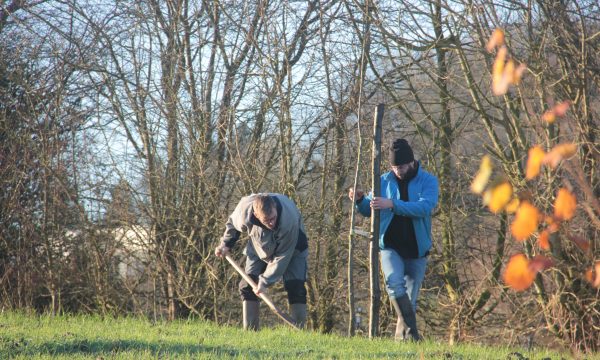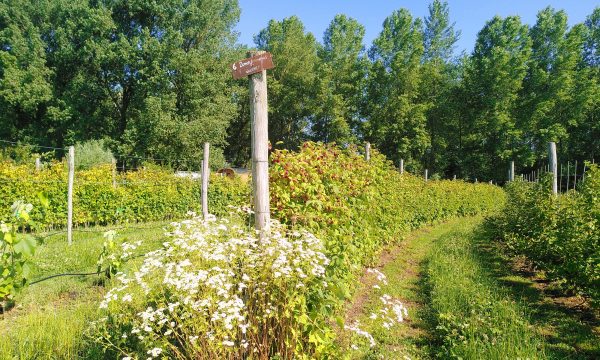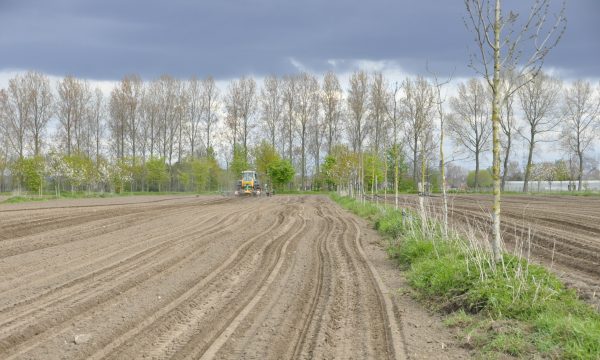Press release 10 years of Agroforestry Flanders: Studies show potential and interest is growing, but there is still no broad implementation. What is the way to 2035?
Up to 7 tons of additional CO2 storage per hectare per year, a protective microclimate, better water management, more biodiversity, higher overall productivity despite an average 20% lower yield from agricultural crops, and a business model that is profitable under most scenarios. That is the proven potential of agroforestry or forest agriculture after 10 years of research by the Consortium Agroforestry Flanders. The results were presented today at ILVO at the event "Farming with trees: the road to 2035." More than 200 farmers, policy makers, researchers and other stakeholders participated and provided input for a roadmap with concrete action points to make Flanders a stimulating environment for agroforestry. Mark Shepard, American pioneer and author of Restorative Agriculture, inspired with a keynote on water management.
Flemish Minister for Agriculture and Environment Jo Brouns closes the day with these encouraging words: “Agroforestry is booming, and rightly so! Combining trees and agriculture is not only a return to age-old practices, but also a powerful step toward a more sustainable future. With support from Flanders and support for planting and maintenance, together we can continue to build a healthy and future-proof agricultural sector.!”
New handbook
The partners of the Consortium Agroforestry Flanders are ILVO, Inagro, Bos+, Bodemkundige Dienst België, Boerennatuur Vlaanderen, Wervel, Praktijkpunt Landbouw Vlaams-Brabant and UGent. Over the past 10 years, they have collaborated in more than 20 projects focusing on research, knowledge sharing, learning networks, farm guidance, policy work and implementation in the field, among other things. This resulted in many concrete figures on the impact of trees on crop production, soil quality, carbon sequestration, biodiversity and profitability. All current info can be found in the updated Handboek Agroforestry in Vlaanderen 2014 - 2024: Leidraad na 10 jaar Onderzoek en Praktijkwerking (zenodo.org).
Impact: additional carbon storage per hectare
Trees store carbon in the wood, but researchers also systematically measure increased carbon content in the soil near the trees. There is variation depending on soil type, climate context, tree species, and so on, but generally agricultural plots store a significant amount of additional CO2 per hectare per year by adding trees. In some systems, this amounts to 7 tons or more.
Impact: buffering or protective microclimate
There is also a proven buffering effect of trees on the environment such as wind, temperature and precipitation. In extreme weather conditions, trees break tight winds and protect crops, provide shade and shelter for grazing livestock, and prevent erosion. Even on soil water balance, trees have a buffering effect. There may be competition between tree and crop, but with thoughtful planting and management, trees slow down and redistribute available water, benefiting soil and crops and reducing flooding.
Impact: more variety in plants attracts different animals
Agroforestry leads to increased biodiversity by adding woody species and the additional plant species that grow in the woody strips. An herbaceous/flower-rich mixture is often sown between the tree row. This greater variety of plants provides suitable habitat and foraging areas for a variety of animal species. Birds and bats use these corridors in the landscape, but beneficial insects that provide pollination such as (solitary) bees are also more common. Several studies further demonstrated the positive effect of agroforestry on natural pest controllers. The link between the higher presence of pest-controlling species such as ladybugs or parasitic wasps and the effective control of pests in the field is more difficult to establish scientifically.
Impact: yield and overall productivity
Although the overall productivity of an agroforestry system is always higher, the conventional agricultural crop next to the trees usually has to lose some production. In a good year with moderate, Flemish weather, especially summer crops in agroforestry yield less than in a conventional agricultural system, due to the competition between tree and crop for light and water. On the other hand, trees can positively influence crop production in extremely dry or hot periods, especially on grassland. This is evident from the systematic monitoring of field plots in Flanders. On their own demo and experimental sites, ILVO, Inagro and Praktijkpunt Landbouw Vlaams-Brabant are investigating how productivity can be optimized, for example through smart design and smart species and variety choices. One of the basic principles of agroforestry is that the decrease in crop yield is partially or even overcompensated by the production of wood as biomass, fruit and nuts. There is risk diversification and an opportunity to tap into new markets, such as local nuts, fruit juices or ciders. Soon, the Consortium will publish some more
Bert Reubens, coordinator of the Consortium Agroforestry Vlaanderen (ILVO): “ The trump card of agroforestry is the enormous multifunctionality of the system: it can contribute to both resilience to climate change, flooding, erosion control, yield losses in the event of heat, loss of biodiversity, heat stress in animals... It's a win-win-win.”
Roadmap: Towards a supportive environment for agroforestry in Flanders
Since the agroforestry subsidy was created in 2012, about 280 hectares of new agroforestry plots have applied for support. The total acreage is higher because not all farmers apply for the grant, but implementation remains limited regardless. To create an enabling environment for agroforestry, the Consortium is publishing (soon to be finalized) a roadmap of priority actions by 2035.
This included input from the master classes, field trips, workshops and analyses the Consortium organized or conducted in recent years. According to the roadmap, there is work to be done on five "paths": in research and development, education, policy, economy and social environment. Concrete bottlenecks cited include access to land, fair prices, compensation for ecosystem services but also lack of experimentation space by pioneering farmers and the need for independent advice and guidance.
Marlinde Koopmans, researcher from Consortium Agroforestry Vlaanderen (ILVO): “The number of agroforestry pioneers is growing in Flanders, the Netherlands and the rest of Europe. Yet for the system to be widely rolled out, policy, agricultural education, the industry itself, consultants and the broad agri-food chain must form an enabling environment that recognizes and propagates the practices of the pioneers. This applies, incidentally, to all innovative forms of agriculture, including agroecology or restorative agriculture.”
The final version of this Roadmap will be available as of November 2024 on this webpage.
Three demo sites and numerous tools for farmers
In addition to research, over the past 10 years the Consortium has developed a package of practical tools for farmers. There are five decision support tools to help with construction and maintenance, six online teaching modules, fact sheets with directional cost-benefit analyses, and so on. All that material can be found on the website www.agroforestryvlaanderen.be.
New is the Agroforestry Map on which existing agroforestry plots gain visibility, in addition to knowledge institutions and consulting providers. The goal is to promote cooperation in the chain and help potential buyers of agroforestry products find potential suppliers. Three experiment and demo sites were also set up on the site, at ILVO, Inagro and Praktijkpunt Landbouw Vlaams-Brabant. Each has its specificity and focus.
Willem Van Colen, researcher from the Consortium Agroforestry Vlaanderen (Inagro): “There is a need for cultivation knowledge and good working examples. With our permanent experimental demo sites in three locations in Flanders, we want to meet this need.”
Three agroforestry ambassadors
During the event, three "agroforestry ambassadors" were honored: people who have played an important role in putting agroforestry on the map in Flanders in recent years, or who will occupy a key position in the near future. The choice fell on Jeroen Watté, the duo Louis-Marie Tennstedt-Wouter De Stecker, and Daphne Ruigrok. Jeroen Watté is a former employee of Wervel and already brought agroforestry to the attention of Flanders in 2010. Louis-Marie Tennstedt is one of the very first pioneer farmers. His son-in-law Wouter De Stecker continues his agroforestry work. As a policy implementation advisor at the Agency for Agriculture and Marine Fisheries, Daphne Ruigrok helps farmers who want to get started with agroforestry.
More info
American author Mark Shepard gave a keynote focusing on water management. That keynote was recorded in full and will soon be online at the Consortium website. All other presentations are available there.



